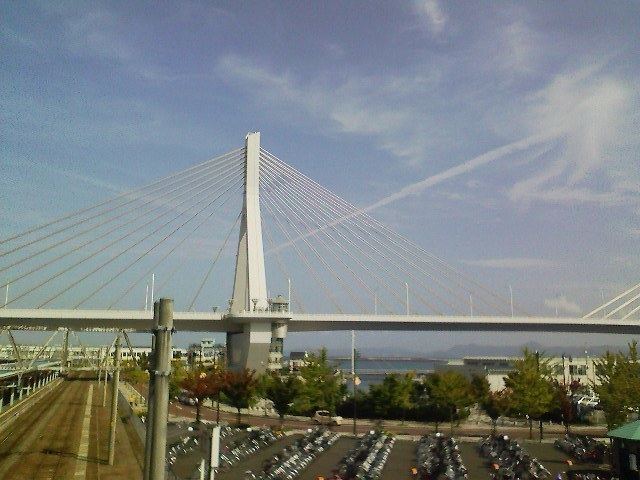Width 25 m Location Aomori Bridge type Cable-stayed bridge | Opened July 1992 Phone +81 17-734-4101 | |
 | ||
Carries Four lanes of automobile traffic for Aomori Port Road Route 2 Total length 1219.0 m (center span 498 m, land-side spans 721 m) Similar Aomori Prefecture Tourist C, Hakkoudamaru, Nebuta house Warasse, Asamushi Aquarium, Hakkōda Ropeway | ||
Aomori bay bridge walk
The Aomori Bay Bridge (青森ベイブリッジ, Aomori Bei Buridji) is a cable-stayed bridge in Aomori City, Aomori Prefecture. It was constructed in order to alleviate cargo ship traffic. It is a famous part of Aomori City's scenery.
Contents
- Aomori bay bridge walk
- Aomori bay bridge crossing by bicycle august 2014
- Details
- Development
- Major Connecting Roads
- Surrounding Area
- References
Aomori bay bridge crossing by bicycle august 2014
Details
The Aomori Bay Bridge is the longest in Aomori City at 1219 meters. It's the second longest bridge in Aomori Prefecture after the 1323.7 meter Hachinohe Ōhashi Bridge. Previously the longest bridge in Aomori City was the 993.9 meter Aomori-nishi Bypass overpass, now the third longest bridge in Aomori Prefecture.
Emphasis was placed on the aesthetics of the bridge, causing the total cost of construction to come to approximately 27 billion yen (¥) in comparison to only ¥8.9 billion for the longer Hachinohe Ōhashi Bridge. An example of the emphasis on the bridge's appearance is the emblazoning of the letter "A", for "Aomori", at various places such as the base of the bridge and in the shape of the suspension cables. The use of the letter "A" continues on from the nearby Aomori Prefecture Sightseeing Products Mansion, or ASPAM Building, which is built in the shape of a triangle so that it would look like the initial "A".
The bridge's main tower is made from high strength concrete.
In response to the bridge's long standing problems with ice in the winter months, a plan was made to lay pipes circulating sea water under the road surface to melt the ice. However, due to problems related to the cost and construction time, only one section was able to be completed. As yet there are no indications of when the system will be implemented over the remainder of the bridge as originally planned. Even so, since the installation of the system the number of traffic accidents has drastically decreased.
